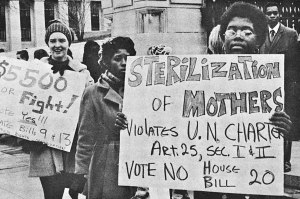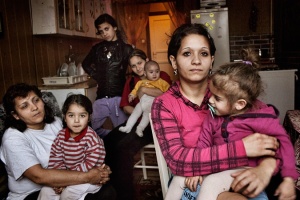Forced sterilization of Romani women – a persisting human rights violation
“I decided to come out with my story so that it doesn’t happen to other women, to our children, to our grandchildren. So that they never find themselves in the situation I am in today.”
Elena Gorolova, victim of forced sterilization, interview for Romedia’s I’m a Roma Woman campaign.
Between 1971 and 1991 in Czechoslovakia, now Czech Republic and Slovakia, the “reduction of the Roma population” through surgical sterilization, performed without the knowledge of the women themselves, was a widespread governmental practice. The sterilization would be performed on Romani women without their knowledge during Caesarean sections or abortions. Some of the victims claim that they were made to sign documents without understanding their content. By signing these documents, they involuntarily authorized the hospital to sterilize them. In exchange, they sometimes were offered financial compensation or material benefits like furniture from Social Services – though it was not explicitly stated what this compensation was for. The justification for sterilization practices according to the stakeholders was “high, unhealthy” reproduction.
They sterilized thousands of Roma women in this way. The Czech ombudsman estimated that more than 90,000 women from former Czechoslovakia became infertile as a consequence of such interventions. If the evidence for such treatments performed in the past is not alarming enough, there seems to be proof that this practice was not only common during the Communist era: there are women reporting the same crime in post-Communist times as well, even after Czechoslovakia split into Czech Republic and Slovakia. In what is today Slovakia, 1000 Roma women and girls were sterilized annually in the 1980s. Unfortunately, the practice of forced sterilization in this region of Europe seems to persist to some extent, with cases emerging in other countries as well.
The European Roma Rights Centre pointed at two cases of Romani women who were sterilized in Hungary without their consent. One of them relates back to 2001, when a young woman, A.S. accused a hospital for sterilizing her without her knowledge. Following eight years of intensive lobbying, with several organizations started pressuring the government, in 2009 the Hungarian state compensated A.S. The court acknowledged that the surgery was performed without her knowledge, but it also claimed that the surgery did not harm A.S.’s reproductive capacity as the sterilization was purportedly “reversible”. The second case taken up by ERRC is still in process, as it was rejected in the first instance by the Hungarian Court.[1]
The victims of forced sterilization have begun to speak out against these crimes by creating a movement to stop forced sterilization and bring justice to the victims in the Czech Republic as well. Czech Romani activist Elena Gorolova was one of those who started the movement by founding Group of Women Harmed by Forced Sterilization. She is a victim too, sterilized while having her second child in 1990. Mrs Gorolova, like many other Romani women, was not able to file a civil lawsuit because the deadline for seeking legal action had already expired. Nevertheless, she tried to pursue legal justice with other women, moving her case from the local to the national and international level. They organized demonstrations, such as the one in Ostrava in front of the hospital infamous for sterilizing Romani women in large numbers. Elena is one of the eighty-seven women who sent their complaints to the Czech ombudsman, reporting forced sterilization. In December 2005, in his final statement on the issue, the ombudsman declared that sterilizations performed on Romani women are illegal.[2]
The story of Elena and the others is not the first policy of compulsory sterilization in history. The first was documented in the US in the beginning of the 20th century. African-American women were sterilized against their will, many of them without their knowledge, while they were in a hospital for other reasons or sometimes even while serving a prison sentence. More than 65,000 individuals were sterilized in 33 states in the framework of compulsory sterilization programs. This US policy was followed by several other countries, including Canada, Russia and Germany, that approved compulsory sterilization as a governmental practice.
In the case of the Czech Republic and Slovakia, many lawsuits ended with the victory of the victims of sterilization. However, most of the pursuers kept their identity secret or the outcome of the case was not made public for other reasons. Elena Ferencikova was the first Roma women to sue the Czech Health Authority in 2005 for the damages she suffered when they sterilized her at the age of only nineteen.[3] The court didn’t decide on financial compensation but the hospital where they performed the intervention apologized for sterilizing Elena without her agreement, damaging her future and her harming her status in her community. At the time of the intervention, she was a young bride, with the dream of having a big family.
Until the most recent past, over 87 Romani women filed an official complaint against the Czech health authority The first action on the government’s behalf was an apology in 2009 during a press conference, followed by the report from the Czech Ombudsman about the illegality of the practice in 2005.[4]
Among the individual cases which ended in favor of the victims is that of Iveta Červeňáková who sued the Czech Republic for sterilizing her about fourteen years ago. Her case was in front of the Ostrava Regional Court for one million Czech crowns compensation, since she never requested the surgery. After losing the case, the hospital appealed to the High Court in Olomouc, claiming that her right for financial compensation expired and she can only win an apology. But their statement was not accepted and the Czech Supreme Court decided that Ms Červeňáková still has the right for financial compensation. The case was concluded with an out of court settlement between the hospital and the victim. The details are confidential between the two parties. [5]
The above case seems to be rather typical: the content of out of court settlements is not made public and the reason that women gained mere apologies from the hospitals is usually due to an allegedly expired right for financial compensation. On the other hand, there are cases whose outcome was made public, like one from 2012: the court made the decision that the government was at fault and the woman in question should receive a compensation of EUR 10,000.[6]
Looking at several cases of forced sterilization, a serious infringement of human rights is what should be emphasized, as reflected also by the recommendations from the NGOs’ side, the ERRC and the Czech Government Human Rights Commissioner Monika Šimůnková, who all stress the need for developing a compensation mechanism for all victims of sterilization. A well-functioning mechanism is needed since not all victims are literate enough, have the financial sources, or the knowledge to ask for justice in court. Majority of Czech ministers agreed and a mechanism should be developed by the end of 2013, as part of the already existing legal framework. However, there is a concern that many of the affected women will still be excluded from the opportunity to gain justice.[7]
To add a personal perspective on the issues at stake, I see many reasons justify the need for the government to develop a compensation mechanism. For instance, trends show they are losing cases on the international level. Developing such a mechanism would mean that the cases would remain on the local or national level. Another reason could be financial: whatever compensation mechanism the government develops, the amount of compensation is not equivalent to the cases decided by the European Court of Human Rights. The third reason could be that authorities are trying to escape the negative backlash caused by not assuming responsibility and not criminalizing this governmental practice. In conclusion, the development of a compensation mechanism could keep “embarrassing” cases from reaching international publicity, which could lead to public ignorance if no one realizes how many actual victims there are and in what circumstances these crimes happened.
Of course, one could also argue that after years of injustice affecting hundreds of women, the fact that some women will receive justice might pave the way for others. Still, the question must be asked: is this enough? Is compensation enough? I am concerned that whatever compensation they eventually receive, the truly important development would be if governments themselves are seriously pushed to criminalize forced sterilization: only this could prevent these horrible stories from repeating themselves.
While human rights can be violated by individuals or by institutions, they can only be defended by institutions. The European Court of Human Rights does not deal with single individuals who have committed crimes. Rather, it focuses on why the government in question could not take action against what happened. But where are the doctors, politicians and all the people who personally contributed to or carried out such surgeries, and when they are going to take responsibility for their actions? In order to take action against this human rights violation, blaming the Communist regime is not enough. The practice continues today and forcibly sterilized Romani women are still a long way from receiving true justice.
Written by: Galya Stoyanova, Romani intern at Romedia Foundation
[1] Albert, Gwendolyn. “Forced Sterilization and Romani Women’s Resistance in Central Europe.” Forced Sterilization and Romani Women’s Resistance in Central Europe. N.p., 2011. <http://popdev.hampshire.edu/sites/popdev/files/uploads/u1149/DT_71_Albert.pdf>.
[2] Ibid.
[3] Holt, Ed. Roma women reveal that forced sterilization remains. N.p., 12 Mar. 2005. Web. <http://www.thelancet.com/journals/lancet/article/PIIS0140-6736(05)71063-1/fulltext>.
[4] Decade of Roma Inclusion . Czech Prime Minister Apologizes to Victims of Coercive Sterilization. N.p., n.d. Web. 1 Feb. 2013. <http://www.romadecade.org/czech_prime_minister_apologizes_to_victims_of_coercive_sterilization>.
[5] Stop Torture in Healthcare. <http://www.stoptortureinhealthcare.org/news-and-resources/forced-sterilization/czech-hospital-pays-romani-woman-forcibly-sterilized-14-year>
[6] ROMEA. Czech Gov. compensates another woman over illegal sterilization. N.p., 11 Dec. 2012. Web. 1 Feb. 2013. <http://www.romea.cz/en/news/czech/czech-govt-compensates-another-woman-over-illegal-sterilization#>.
[7] Open Society Foundations. Against her will – Forced and coerced sterilization of women worldwide.
<http://www.opensocietyfoundations.org/sites/default/files/against-her-will-20111003.pdf>






Reblogged this on marikaschmiedt.
Pingback: 8 aprilie este Ziua Internationala a Romilor. | Ziua Internationala a Romilor - 8.04.2013
Pingback: 8 aprilie este Ziua Internationala a Romilor | 8 aprilie
Pingback: Sterilizarea femeilor rome | 8 aprilie
Pingback: Sleepwalk to Separation: The lessons of the Velvet Revolution » Open Unionism
Pingback: Forced sterilization of Romani women – a persisting human rights violation | jsreidy
Pingback: Forced sterilization: Europe is still torturing Romani women | jessica reidy
Pingback: Europe’s Forgotten Citizens | International Political Forum
Pingback: Blonde Angel Blunder | Charles Bell
Pingback: Things to Ruin Your Day – Forced Sterilization of the Roma | Dead Wild Roses